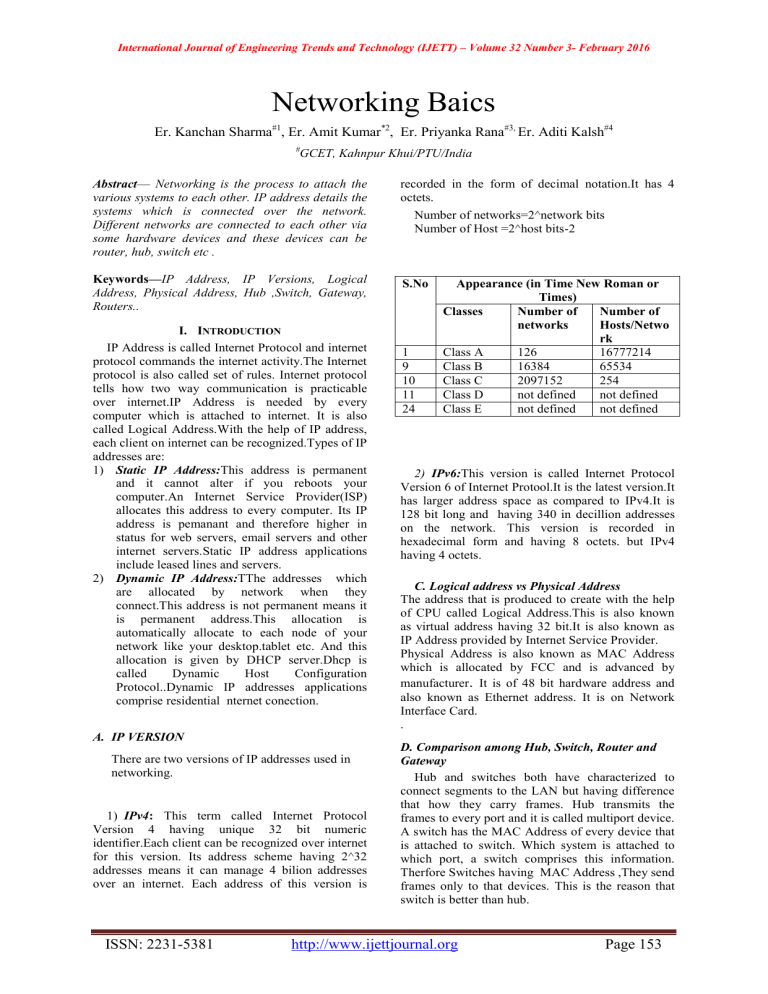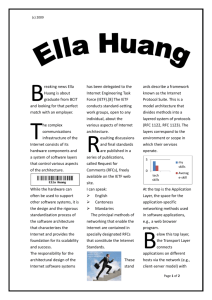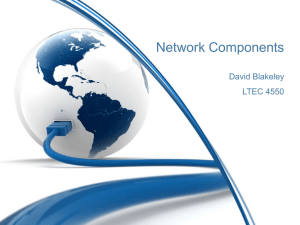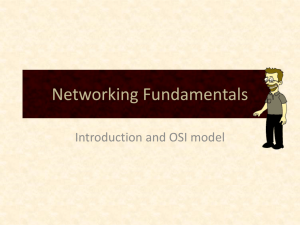Document 12917243

International Journal of Engineering Trends and Technology (IJETT) – Volume 32 Number 3- February 2016
Networking Baics
Er. Kanchan Sharma
#1
, Er. Amit Kumar
*2
, Er. Priyanka Rana
#3,
Er. Aditi Kalsh
#4
#
GCET, Kahnpur Khui/PTU/India
Abstract — Networking is the process to attach the various systems to each other. IP address details the systems which is connected over the network.
Different networks are connected to each other via some hardware devices and these devices can be router, hub, switch etc .
Keywords — IP Address, IP Versions, Logical
Address, Physical Address, Hub ,Switch, Gateway,
Routers..
I.
I NTRODUCTION
IP Address is called Internet Protocol and internet protocol commands the internet activity.The Internet protocol is also called set of rules. Internet protocol tells how two way communication is practicable over internet.IP Address is needed by every computer which is attached to internet. It is also called Logical Address.With the help of IP address, each client on internet can be recognized.Types of IP addresses are:
1) Static IP Address: This address is permanent and it cannot alter if you reboots your computer.An Internet Service Provider(ISP) allocates this address to every computer. Its IP address is pemanant and therefore higher in status for web servers, email servers and other internet servers.Static IP address applications include leased lines and servers.
2) Dynamic IP Address: TThe addresses which are allocated by network when they connect.This address is not permanent means it is permanent address.This allocation is automatically allocate to each node of your network like your desktop.tablet etc. And this allocation is given by DHCP server.Dhcp is called Dynamic Host Configuration
Protocol..Dynamic IP addresses applications comprise residential nternet conection. recorded in the form of decimal notation.It has 4 octets.
Number of networks=2^network bits
Number of Host =2^host bits-2
S.No
1
9
10
11
Appearance (in Time New Roman or
Times)
Classes
Class A
Class B
Class C
Class D
Number of networks
Number of
Hosts/Netwo rk
16777214 126
16384
2097152
65534
254 not defined not defined
Class E not defined not defined 24
2) IPv6: This version is called Internet Protocol
Version 6 of Internet Protool.It is the latest version.It has larger address space as compared to IPv4.It is
128 bit long and having 340 in decillion addresses on the network. This version is recorded in hexadecimal form and having 8 octets. but IPv4 having 4 octets.
C. Logical address vs Physical Address
The address that is produced to create with the help of CPU called Logical Address.This is also known as virtual address having 32 bit.It is also known as
IP Address provided by Internet Service Provider.
Physical Address is also known as MAC Address which is allocated by FCC and is advanced by manufacturer
.
It is of 48 bit hardware address and also known as Ethernet address. It is on Network
Interface Card.
.
A.
IP VERSION
There are two versions of IP addresses used in networking.
D. Comparison among Hub, Switch, Router and
Gateway
1) IPv4 : This term called Internet Protocol
Version 4 having unique 32 bit numeric identifier.Each client can be recognized over internet for this version. Its address scheme having 2^32 addresses means it can manage 4 bilion addresses over an internet. Each address of this version is
Hub and switches both have characterized to connect segments to the LAN but having difference that how they carry frames. Hub transmits the frames to every port and it is called multiport device.
A switch has the MAC Address of every device that is attached to switch. Which system is attached to which port, a switch comprises this information.
Therfore Switches having MAC Address ,They send frames only to that devices. This is the reason that switch is better than hub.
ISSN: 2231-5381
http://www.ijettjournal.org
Page 153
International Journal of Engineering Trends and Technology (IJETT) – Volume 32 Number 3- February 2016
A router is different device as compared to hub and switch. A switch’s job is to route packets while switch and hub convey frames not packets. A packet contains address and data too. A router’s function is to attach atleast two networks. These networks can be LANs, WANs and ISP’s network. The routers always found at Gateways. A Gateway is also a computer which is used to route the data from workstation to outer network. A gateway is also called Internet Service Provider that is use to attach user to the internet. A gateway node whice is also act as proxy server and firewall.
B.
Firewall vs Proxy Server
Proxy server is server which works in between client application .It hides internal network from the internet. But Firewall is used to close the ports and programs which try to gain unauthorised access to network.
II.
C ONCLUSIONS
The IP addresses are used to show the number of systems attached to network and hardware devices are used to attach the network.
R EFERENCES
[1]
Microsoft, ―IPv6/IPv4 Coexistence and Migration,‖ White
Paper, Washington, November2001
[2] A. S. Tanenbaum, Computer Networks, Third
Edition, Prentice Hall Inc., 1996, pp. 686, 413,436,
437,449
[3]
T. Dunn, ―The IPv6 Transition,‖ IEEE Internet Computing,
Vol.6, No.3, May/June 2002, pp.11-13
[4] W. Richard Stevens, TCP/IP Illustrated,Volume 1: The
Protocols, First Edition December 15, 1993
[5] IETF IPv6 Transition Working Group, http://www.6bone.net/ngtrans.
[6] IPv6 users’ site: http://www.ipv6.org
[7] IPv6 Forum
[8] Experiment During CeBIT 2001,
‖
Computer Networks:
The International Journal of Computer and
Telecommunications Networking, Volume 41 , Issue 3,
February 2003, pp. 303 –312.[2]
[9] Introduction to data communication and networking,
Behrouz Forouzan, TMH.
[10] O’Hara, B. and Petrick, A., IEEE 802.11 Handbook: A
Designer’s Companion, Standards Information Network,
IEEE Press, New York, New York, 1999.
ISSN: 2231-5381
http://www.ijettjournal.org
Page 154




